For many, the rat is not associated with a pet, but they are quite cute and smart, and therefore are popular. In order for the pet to feel healthy, the owner will need to properly organize his food and exclude some foods from the diet.
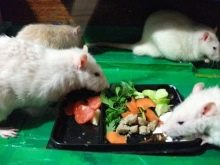
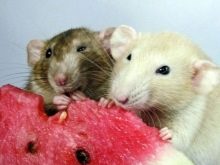
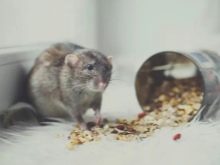
Allowed Products
Caring for a decorative domestic rat is easy, as it can eat fruits, vegetables, grains, pasta, dairy products, and even meat can be present in its diet. Despite the fact that these animals are considered to be rodents, only plant products should not be present in their diet. Food must be balanced, the portions give the same in the morning and evening.
Not a single rat that is healthy will refuse a treat if it lies next to the main food. Sometimes they go to the trick and stop eating specifically to beg the owner for something tasty. In this case, it is required to be resistant and not give in, wait until the animal has eaten all the food.
Depending on the nature of the pet, treats sometimes mean completely opposite products.
Some rats simply can’t live without flour worms, while others are not averse to eating cookies. The owner is required not to overfeed the pet, since such products are present in their diet only as an encouragement.
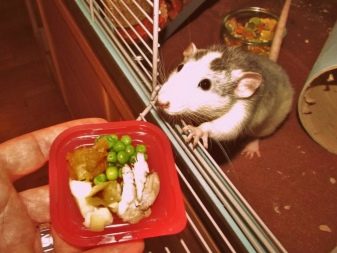

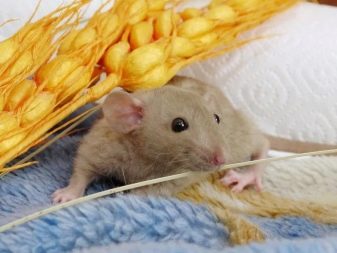

Ready mixes
Corn mix is the main food of domestic rats. It is collected in accordance with the basic needs of the rodent. All ingredients can be purchased separately in the bird market, then mixed.In this case, the finished packaged product has its own advantages, as it is accurately tested and not processed with chemicals. When purchasing grain by weight, you never know under what conditions the product was stored; the only positive side is that you can collect food from the desired ingredients, rather than buying a pig in a poke.
All grain mixtures can be divided into the following classes:
- super premium;
- Premium
- economy

By name, it is easy to guess how the food is different. The most expensive ones are those that are in the first group, they are clearly balanced, have vitamin supplements, do not have high fat content and most often even include animal protein.
Instead of wheat, which is quite expensive, the feed of the second group includes rye or oats. These are mixtures with a high percentage of fat, so you will need to clearly regulate the nutrition of the pet. Protein is introduced additionally.
Mixtures of economy class are very poor in nutrients, they contain a lot of plant granules, and they are of no value to the animal.
If you decide to buy such a product, then it will additionally need to add sunflower seeds, corn, nuts and other ingredients.
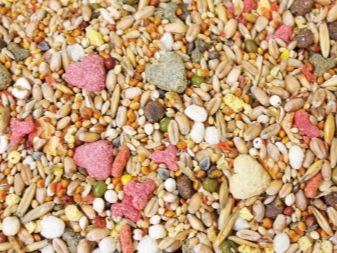


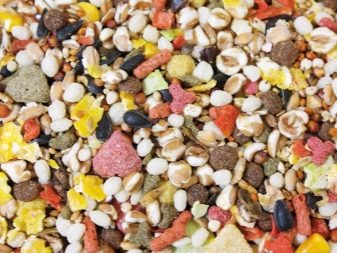
Corn
You should always remember that the grain purchased on the market in most cases is processed by chemical means, so the producer should be chosen more carefully. Of the crops that must be present in the diet of rats, we can distinguish:
- barley;
- sunflower seeds;
- oats;
- millet;
- corn;
- wheat
- bran.
They give the product as crude as possible, since in this form it is healthier and contains more vitamins and minerals.
Grain is constantly present in the feed. One tablespoon of an adult is enough per day, but a growing body with an intensive metabolism will need to provide constant access to such food.

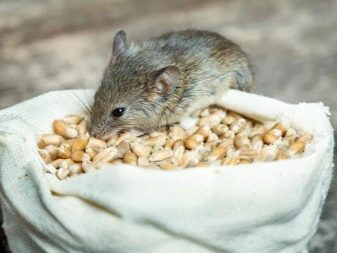
Fruits and vegetables
In relation to grain feed, these products must be present in the animal’s diet in a ratio of 1: 2 or 1: 1. You can not transfer the rat solely to a diet in which only vegetables are present. Carrots, zucchini, greens and cucumbers are well suited for their nutrition. Beets can cause diarrhea.
Apples, raspberries, apricots, currants and peaches can also be given to animals. As for grapes, from it in rats gas formation increases.
Fruits and vegetables are low-calorie, but healthy food, there is no norm for its consumption, but the main thing is that there should be grains in the diet of rodents along with them. They should always be fresh, so everything that the rat was fed up yesterday is cleaned. Yesterday's rats cannot eat perishable foods; this causes poisoning in the animal.
Peas, turnips and radishes also increase gas production. Other legumes in this list, almonds from nuts. Even cabbage should be excluded from the diet for the same reason.
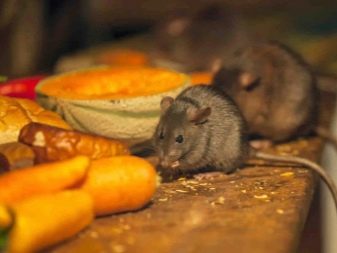

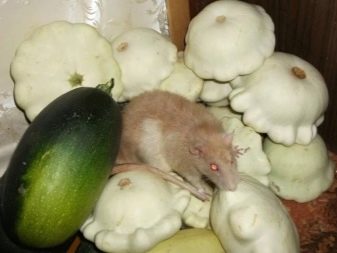

As for citrus and other fruits, tangerines, pomegranates, kiwi, pineapple, oranges because of the high acid content in them, veterinarians were excluded from the list of allowed for decorative rats. Moreover, it can even cause allergies. It is better to give persimmons, avocados, pears. Boiled potatoes are rarely allowed to be given to an animal that is raw, and even more so sprouted, is strictly prohibited.
In winter, the rat will be happy with the sprouted grain, in summer you can throw a bunch of fresh grass into it, but you should not just collect it along the road. Before you put greens in the cage, it must be washed and poured with boiling water. About 10% of the total diet is greens, on average for each individual per day it needs no more than 12 grams.
Experienced rat breeders know how important food seasonality is. In spring, it is very good to replenish vitamins and minerals with dandelions and fresh grass; in summer, you can please the animal with carrots or berries. Autumn is rich in fruits, and in winter, all the nutrients are enclosed in root crops.

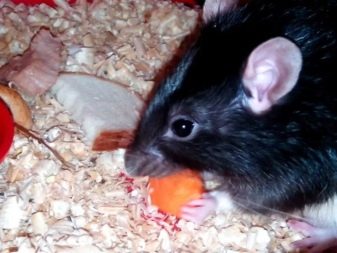

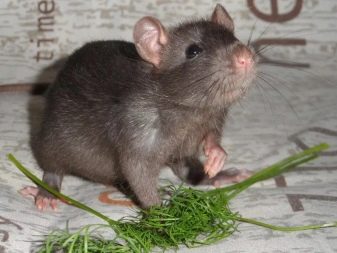
Meat
Under meat products understand animal feed. They should be given to rats in small portions a couple of times a week.
Chicken bones are a great addition to the rat’s menu, but they need to be given only boiled. You can treat your pet with meat, but not pork, as it is too fat. Rodents like to enjoy boiled fish and even quail eggs, but if a yolk is given, it is first wetted, otherwise the rat may choke on it.


Dairy products
Dairy products are introduced into the diet of pets gradually, first checking it for digestibility. At an early age, calcium, which is found in dairy products, will be most useful. Too often, milk and its derivatives do not give, otherwise you may encounter upset stomach in rats. If fermented milk supplements such as kefir or yogurt are used, then they must be without dyes, and preferably fat-free.
Cottage cheese and ryazhenka can also be introduced into the diet. It is very beneficial for pregnant females to use raw milk. Condensed milk is strictly forbidden, it contains a huge amount of sugar that is not absorbed by the rat. Cheese, sour cream and cream are also prohibited.

Rodent Treats
There are foods that rats love the most, including walnuts, hazelnuts, seeds. Unsweetened cookies are also a delicacy, like a piece of fresh young carrots, boiled pasta or even cracker. There are special treats in the pet store - drops. They are made with different tastes from various ingredients.
It is impossible to indulge rats with such food, once a day will be enough. Drops are allowed to give no more than 6 pieces per day. These candy-based nutritional supplements are sweet but not beneficial. In addition, not every manufacturer responsibly approaches the process of manufacturing drops and is not always ready to indicate the true composition of the goods.
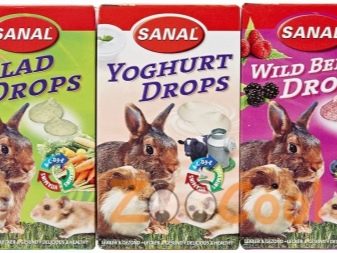
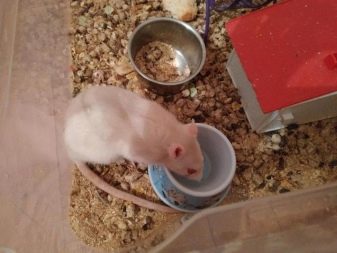
It is also necessary to delight your animal with snacks correctly, therefore choose products that do not contain sugar and salt, there should be no flavorings and spices in them. You can give dried fruits or nuts every day. Most individuals cannot deny the pleasure of eating cornflakes, but they should be free of sugar and salt.
Diabetics have unsweetened cookies in the diet, which can also be attributed to the delicacies that the described animals adore. Food for young children will also please the animal, for example, mashed potatoes. You can make it from fruits and vegetables and on your own, as natural products will bring more benefits than purchased.
Not everything that seems tasty to a person is suitable for a rat, this applies to meatballs with sauce and other products from the table. A slightly dried pet bread will be much better. If it has bran, granola or cereals, then the pet will be in seventh heaven.
If the rat has a sweet tooth, you can spread a little honey on a slice or give it some dark chocolate, but you should not abuse it.


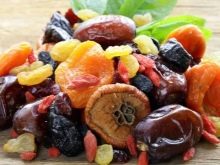
If the animal has become a full member of the family, then you can please him with a treat of his own preparation. A wonderful and useful option at the same time - cereal from cereals and vegetables or fruits. In the summer, it can be zucchini, possibly pumpkin, in winter it is easy to get by with a frozen mixture from the supermarket.
Vegetables are baked or steamed, cereals are steamed or lightly boiled. A small amount of sunflower oil and a quail egg are added to the mixture. The rat will not be able to refuse steamed omelettes, but to add to it is not milk, but water. Steamed meatballs with vegetables are also a great alternative to a delicious dinner for the animal, but it is best to take beef in this case.
Of the crustacean rats, they enjoy gammarus, which is added to the finished buckwheat.
You need to know that young pups do not always readily eat fresh vegetables, but they really like baked ones.
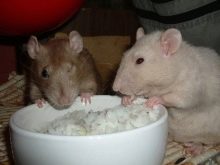

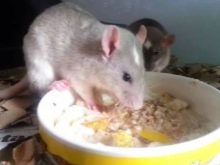
What should not be given?
There is an opinion that decorative rats, like their wild relatives, are omnivorous, in fact, this is not so, since there is a clear list, dictated by veterinarians that they should not be given:
- banana;
- chocolate and other sweets;
- raw potatoes;
- tea;
- fresh bread;
- soda and alcohol;
- bread;
- beet;
- grapes;
- spinach.
This is not a complete list. There are other foods that can cause rodent health problems.


Spinach, cocoa and soybeans should also be absent from the diet, as well as boiled cereals, eating which often leads to a significant increase in the weight of the animal. It is enough just to pour the porridge with hot water so that it is ready for use, but do not boil it.
There is plant food, which is often the cause of the death of the animal, including indoor flowers:
- feces;
- begonia;
- dieffenbachia;
- azalea;
- cyclamens.
If you want to treat a rat with melons, then you should not do this in the early summer, when the fruit contains a lot of nitrates. Sometimes such poisoning leads to the death of the animal, while in humans it causes only malaise. It is possible to feed rats with fruits and vegetables, but it is desirable that they grow in their own area.
Any food in the cage should not be stale, spoiled foods lead to severe poisoning.
If you have any problems, you should contact a specialist. Home self-medication rarely leads to a positive result.
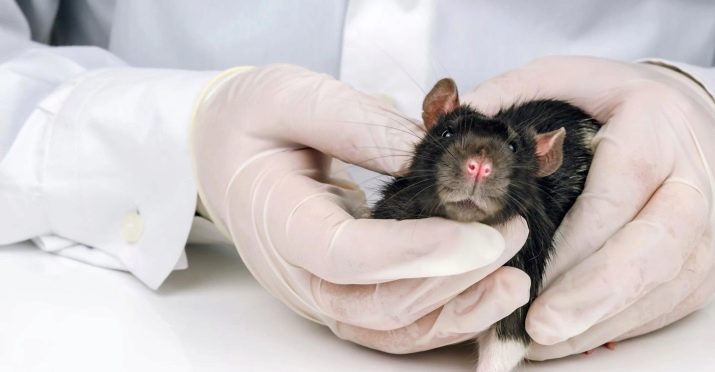
Number and rules of feeding
A rat, like any other pet, should be fed correctly, that is, observe a diet and regimen. If too often to give food from the table, then you can greatly harm the health of the pet. The rat is unable to properly digest salt, sugar, and even spices, let alone dyes, which are increasingly present in store products.
Healthy rats should be based on grain feed.. You can buy it at any specialized store. If you study the composition in more detail, it becomes clear that in the pack there is a collection of seeds and grains that the animal can eat without harm to health. Inside there is always oats, corn and wheat. The cost of such food is quite affordable, in addition, sometimes it has vitamin supplements.
When it is possible to collect food yourself, she must use it. If you have different crops, you just need to mix them in the same proportion. Food should always be in the bowl of the rat, but if the animal is getting fat, then the amount of food is controlled.
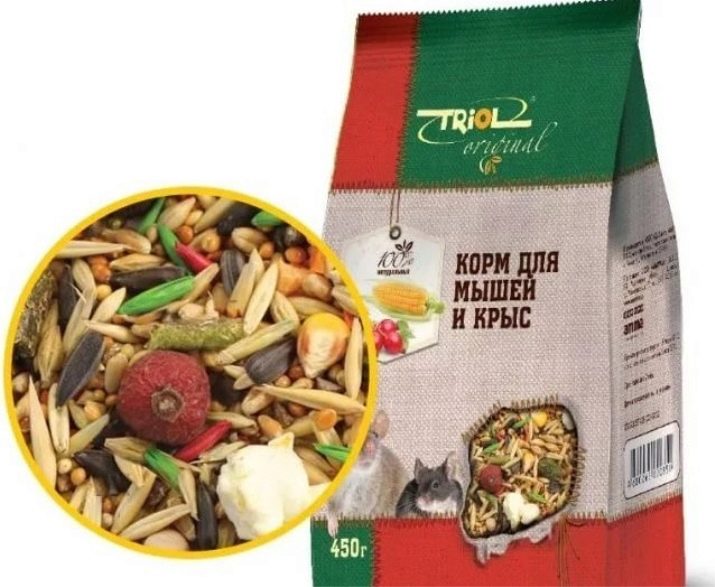
Fruits and vegetables are used as complementary foods, you can give greens, but in small quantities. Such food contains all the necessary minerals and vitamins. The caloric content of such products is reduced, therefore, the weight of the rodent will remain at the required level.
Rats drink water, so they are given a drinker in the cage and make sure that the water in it always remains fresh and clean. Change the water every day.
In addition to the listed products, a chicken egg, in particular, protein, lean meat and even a small amount of fish, can be present in the pet’s diet. Dog food is allowed. Protein is added to the diet no more than 2 times a week, rat pups are given it a little more often.
To compensate for the calcium deficiency, the rat can be given low-fat kefir. The portion should be small, complementary foods are administered no more than once a month.
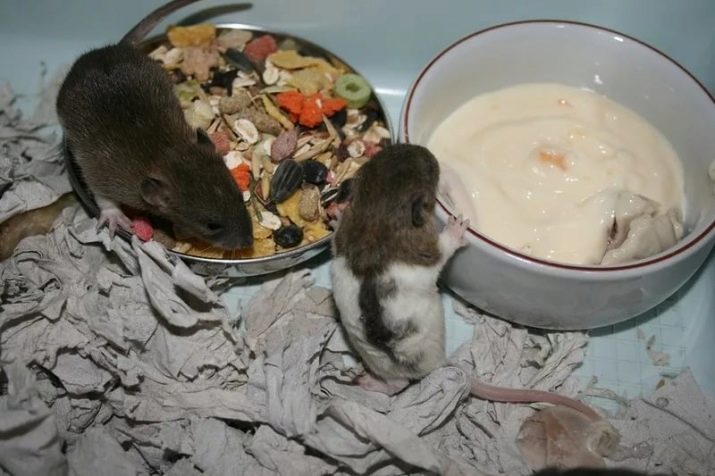
Any living organism needs vitamins and minerals, but decorative animals do not always have the opportunity to get them in the right amount from food. No matter how strange it sounds, but even rats suffer from vitamin deficiency, it negatively affects the pet’s health, especially if calcium and sodium deficiency is observed.
In this case, a lot depends on the owner, how carefully he treats his pet. You can make up for calcium deficiency through the consumption of slaked lime or bone meal. Rock salt is an excellent source of sodium.The liver and even saltwater fish help the rat get the right amount of phosphorus.
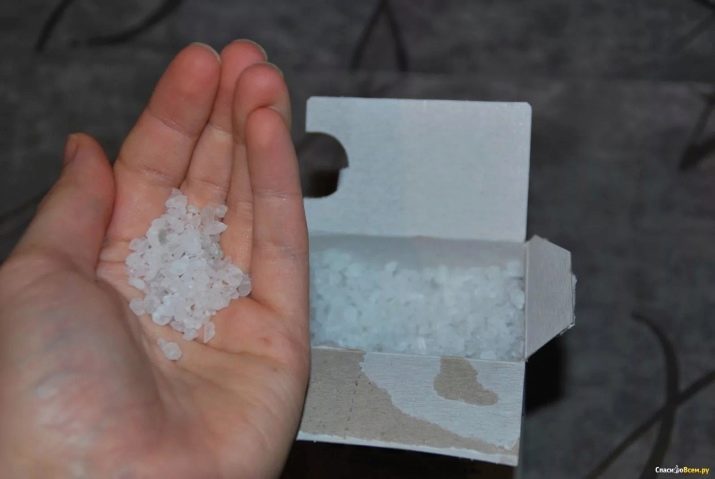
Particular attention is paid to female rats during pregnancy. This is the time when they need more nutrients. Before mating, experienced breeders are advised to limit the amount of carbohydrates and fats they consume and increase the portion of fiber-rich foods. With their obesity, they try to reduce grain feed to a minimum portion.
Pregnant females begin to give more animal protein, that is, meat and fish, chicken cartilage will be an excellent addition to the menu. Chalk and shell rock must be present in their diet, as they are enriched with essential minerals.
Onions, chicken yolk and liver are completely removed from the pregnant rat’s menu, as are bell peppers, tomatoes and even wheat.
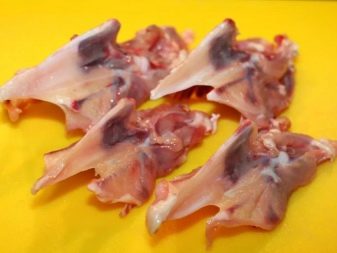

With the correct diet, food is given to the animal twice a day. Most of all, rats are active at night, so the evening dose should be slightly more than the morning. It is possible to violate the diet and often give food to the rat in several cases:
- individuals up to 6 months, because they need more nutrients and calories for growth;
- if the animal is exhausted after another host or after an illness;
- if the rat has signs of diabetes, there should always be food in its trough.
If an individual does not have a predisposition to obesity, then in old age it can be fed more often.

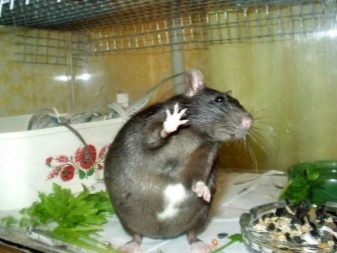
On one rat, 40 grams of grain feed is poured into the feeder, on average it is one tablespoon. Raw fruits and vegetables give no more than 12 grams per day, with the appearance of diarrhea, this amount is halved.
Animal protein should be given as food a couple of times a week, dairy products - only once a month. These types of food are not mixed together in one day. Each new product, as with a small child, is introduced into the diet. gradually to make sure it fits the rat. There are individuals in whom lactose intolerance is observed.
On how to properly maintain a domestic rat, see below.










